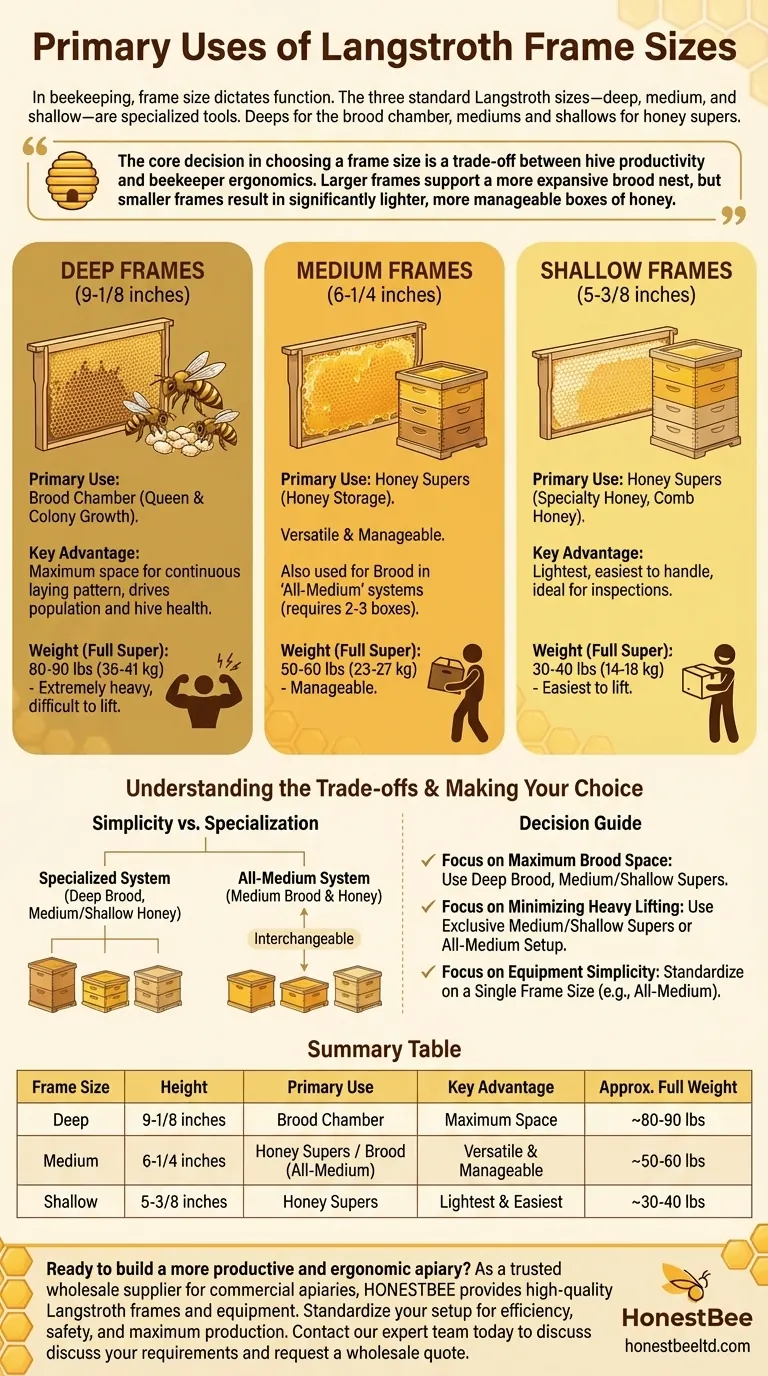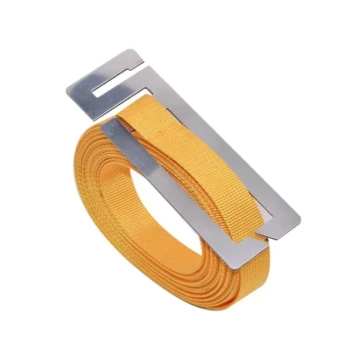In beekeeping, the size of the frame you choose directly dictates its function within the hive. The three standard Langstroth frame sizes—deep, medium, and shallow—are not interchangeable novelties; they are specialized tools designed for different purposes. Deeps are the standard for the brood chamber where the colony raises new bees, while mediums and shallows are used for honey supers, where surplus honey is stored for harvest.
The core decision in choosing a frame size is a trade-off between hive productivity and beekeeper ergonomics. Larger frames support a more expansive brood nest, but smaller frames result in significantly lighter, more manageable boxes of honey.

A Breakdown of Langstroth Frame Sizes
To understand their use, you must first understand their dimensions. All standard Langstroth frames have a width of approximately 19 inches to fit within the hive body, but their height is what differentiates them.
Deep Frames (9-1/8 inches)
This is the largest standard size and the default choice for the brood chamber—the area of the hive dedicated to the queen and the raising of young bees. Its significant volume allows a productive queen to lay eggs in a large, continuous pattern without interruption.
A single deep box provides the substantial space a colony needs to build up its population, which is the engine that drives honey production and hive health.
Medium Frames (6-1/4 inches)
Medium frames, often called "Illinois Supers," are the versatile workhorse of the apiary. Their primary use is for honey supers, the boxes stacked above the brood chamber for honey storage.
Because they are smaller than deeps, a full box of honey is considerably lighter and easier to lift. Some beekeepers also use medium boxes for the brood chamber, though it requires stacking two or even three boxes to equal the volume of a standard deep setup.
Shallow Frames (5-3/8 inches)
Shallow frames are used almost exclusively for honey supers. They are the lightest option, making them the easiest to handle during inspections and honey extraction.
Their smaller size is particularly advantageous for producing specialty honey, such as comb honey, where a perfect, complete frame of honeycomb is the desired end product.
Understanding the Trade-offs
Choosing a frame system is one of the most foundational decisions a beekeeper makes. It impacts your physical workload, your management style, and your equipment inventory.
The Critical Factor of Weight
The most practical consideration is the weight of a full honey super. This is often the deciding factor for many beekeepers.
A full deep super can weigh 80-90 pounds (36-41 kg), making it extremely difficult and potentially injurious to lift. A full medium super is a more manageable 50-60 pounds (23-27 kg). A shallow super is the lightest, at around 30-40 pounds (14-18 kg).
Simplicity vs. Specialization
Using different sizes for brood (deeps) and honey (mediums/shallows) creates a specialized system. The downside is that frames are not interchangeable between the different box types.
To simplify, some beekeepers adopt an "all-medium" system. They use medium frames and boxes for the entire hive, including the brood chamber. This means every frame can be moved to any box, which simplifies management and equipment needs. The trade-off is that you must use at least two medium boxes for the brood chamber, requiring the inspection of more frames to assess the queen and colony health.
Making the Right Choice for Your Apiary
Your physical ability, management philosophy, and beekeeping goals should dictate your equipment choices.
- If your primary focus is a traditional setup with maximum brood space: Use deep frames for the brood chamber and medium or shallow frames for your honey supers.
- If your primary focus is minimizing heavy lifting: Use exclusively medium or shallow frames for your honey supers, and strongly consider an all-medium hive setup.
- If your primary focus is equipment simplicity and interchangeability: Standardize on a single frame size, most commonly mediums, for all components of your hive.
Ultimately, the best system is the one that allows you to manage your bees effectively and safely.
Summary Table:
| Frame Size | Height | Primary Use | Key Advantage |
|---|---|---|---|
| Deep | 9-1/8 inches | Brood Chamber | Maximum space for queen & colony growth |
| Medium | 6-1/4 inches | Honey Supers / Brood (All-Medium System) | Versatile & manageable weight (~50-60 lbs) |
| Shallow | 5-3/8 inches | Honey Supers | Lightest & easiest to handle (~30-40 lbs) |
Ready to build a more productive and ergonomic apiary?
As a trusted wholesale supplier for commercial apiaries and distributors, HONESTBEE provides the high-quality Langstroth frames and equipment your operation needs. We help you standardize your setup for efficiency, safety, and maximum honey production.
Contact our expert team today to discuss your frame size requirements and request a wholesale quote.
Visual Guide

Related Products
- Wooden Bee Hive Frames for Beekeeping and Wholesale
- Langstroth Honey Bee Box Hive Boxes for Different Depths
- Multi-Functional Sliding Hive Entrance for Beekeeping
- HONESTBEE Professional Long Handled Hive Tool with Precision Cutting Blade
- Copper Bee Frame Eyelets for Beekeeping
People Also Ask
- When should bee frames be thrown away? A Beekeeper's Guide to Hive Health & Biosecurity
- What color options are available for plastic frames, and what is the benefit of black frames? Boost Your Hive Inspection Efficiency
- What types of beehive frames are compatible with the honey press? A Guide to Crush-and-Strain Extraction
- What is the role of oxalic acid in plants? A Key to Plant Defense and Internal Regulation
- What are the standard sizes of frames used in Langstroth hives? Choose the Right Frame for Your Apiary



















